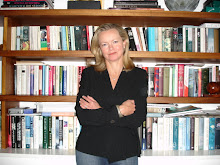
The Herald (2006) This image: copyright Maggie Taylor 2008
In a bid to be right up to the minute, I had hoped to post about Jude Edginton’s magnificent portraits of British Olympic and Paralympic athletes which are on show in a multi-media exhibition on the South Bank outside Tate Modern for the next few weeks. Alas, the images don’t seem to be freely available quite yet. However, as soon as I can get hold of a few, I hope to discuss them. Sponsored by Adidas and by British Olympic Campaign, London 2012, the series highlights several key points about the funding and execution of major photography projects in the 21st century.
On a rainy afternoon last week, I finally made the pilgrimage to Lacock Abbey in Wiltshire where, in 1835, photography pioneer William Henry Fox Talbot (1800-1877) produced the earliest known surviving photographic negative using a camera – a small drawing of the latticed window of the Abbey’s south gallery.

This image copyright/courtesy of National Museum of Photography/Science & Society Picture Library
The Abbey itself was founded in 1232 by the intriguing Countess Ela of Salisbury, as a Nunnery for Augustinian Canonesses. As far as I could work out, it functioned as a kind of refined commune for the posh daughters of gentry, who favoured education and industry over the option of being married off to a philandering or otherwise absent crusader knight. Eventually dissolved by Henry VIII’s commissioners, it was sold in 1539 to Sir William Sharrington, in whose family it remained until his descendant Matilda Talbot donated the Abbey, lands and village to the National Trust in 1946. The Abbey was used as a school for evacuee children during the Second World War and, as I wandered around the medieval Cloister, Chaplaincy and Warming Room, I saw immediately why the producers of the Harry Potter cinema franchise had elected to use these elegant stone arches to stand in for Hogwarts’ hallowed halls.
The small museum dedicated to Fox Talbot and his pioneering work at Lacock is housed in a medieval barn in the Abbey grounds. It does a workman-like job, using various items of Talbot's equipment, objects he photographed and some publications and personal items on loan from the main Collection, which has now moved to the British Library. Perhaps because the Collection - over 4,000 photographs by Talbot and his circle and more than 10,000 letters and other correspondence between Talbot, his family and friends – is now housed in London, the Lacock Museum itself feels sadly like something of an after thought with low ceilings and confusing labelling. I was personally most taken by the few vitrines set up to show the breadth of polymath Fox Talbot’s scholarship in so many other fields, including: mathematics, chemistry, classics, philosophy, botany, Assyriology and archaeology.
The upper barn galleries are used for temporary photographic exhibitions. At the moment & until 14 December 2008, American artist Maggie Taylor is presenting her own take on that perennial artists’ totem: Alice in Wonderland. Taylor works by scanning original 19th-century photographs, line drawings and book illustrations, combining them with her own landscape photographs. These are then layered using digital techniques such as Photoshop, sometimes as many as 60 times, to create a surreal image which is intended to erase the boundary between photography and illustration.
I admit it is an interesting approach and some of the images are quite beguiling but I often wish we could just leave Tenniel alone – If it ain’t broke, why fix it?
Time for Tea? Tum-ti-tum-ti-tum....





